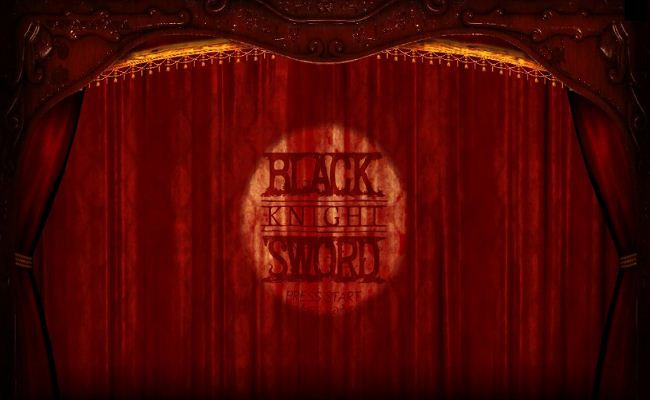“It’s the new game by Goichi Suda”. That’s all that many consumers need to hear. Suda 51, the man behind No More Heroes, Lollipop Chainsaw and Killer 7 has a new thing, and he will now accept your money for it. Meanwhile, other game buyers will want to know crazy things like “Is it good”, and “What’s it about”, or even “What kind of a name is 51 anyway?”
Black Knight Sword is a sidescrolling action-platformer with lots of melee combat, and environmental hazards. This is a common set of mechanics, and in terms of basic gameplay, there isn’t much new here. The Black Knight runs, jumps, double jumps, and augments his sword with magic spells and a projectile attack. As he fights bad guys and hunts down power-ups he slowly accumulates money to buy upgrades and new abilities.
What really separates Black Knight Sword from the pack is the setting, sound, and visual design. It’s presented as a puppet show. The knight and most of his enemies are 3D models, but things in the background or foreground are overtly 2-dimensional as though they’re held up by unseen puppeteers.
This form of meta-story has been used before in The Gunstringer, where players used their Kinect to simulate controlling a character in a puppet show. The upcoming Battle Block Theater is also set inside a live theatre show where players control characters on a stage while malevolent audience members watch the antics. These framing devices show that game story-tellers are looking for new mediums to explore, and hopefully developers will continue working with influences from live theater in the generation ahead.
But aside from the puppet show motif, “Is Black Knight Sword a good game?” Not really. It isn’t bringing much new to the table as an action platformer, and it is sadistically hard. It uses some old-fashion design choices, such as a limited number of lives per level, and players can only heal by finding (Rare) power-ups or buying one-time use healing items from a merchant who never seems to be around when needed most.
Because it is a side-scroller, players have a limited view of the levels. The right analog stick can be used to peek around at places just out of frame, but using this slows the game down, and players might end up making their way through the levels with trial and error. Even with the camera controls, players will still get hit some surprise quick deaths often.
There is a sub-species of player who enjoy very difficult gaming, and they’ll find Black Knight Sword to be a worthy opponent, especially with the additional challenge levels that add in some extra play to a rather short game. There are online leaderboards too, and it should have a particular appeal to the “Speed Run” crowd.
Suda 51 fans are very likely to overlook the fearsome difficulty just to get a look at whatever weirdness he and his team at Grasshopper Manufacture have come up with this time. True to form, Black Knight Sword is an avant garde experience filled with strange encounters and creatures.
The aforementioned merchant is actually a giant eyeball who speaks in a falsetto like John Cleese in drag. The creepy narrator is well aware that he’s narrating a fairy tale, and provides much commentary, even joking at the Player’s misfortunes when dying. The most common enemy type are severed heads that walk around on their own, or can fly. There are other kinds of adversaries too, but Suda 51’s fascination with severed heads continues on as strong as ever.
Those who know what to expect from a game by this developer will find a bizarre adventure that meets their expectations. This one even includes such oddities as collectible potted plants that sprout singing cat heads. Black Knight Sword will have limited appeal, but platforming masochists and fans of Grasshopper Manufacture’s other games will find what they’re looking for here. It is out now for PlayStation Network and Xbox Live Arcade.



0 Comments